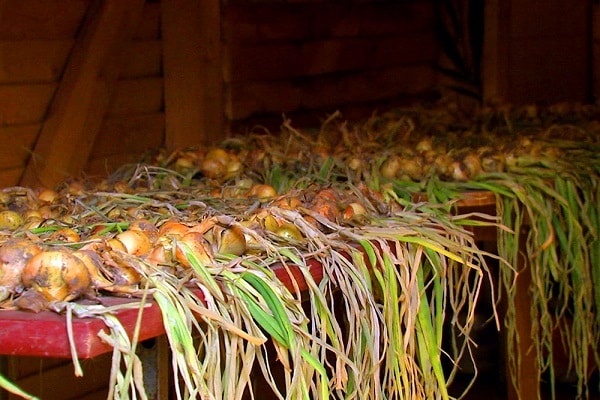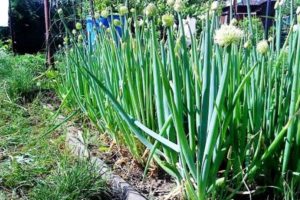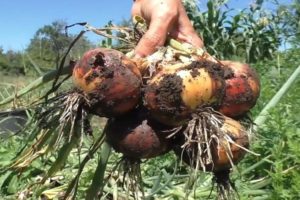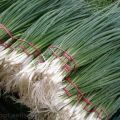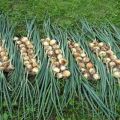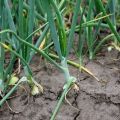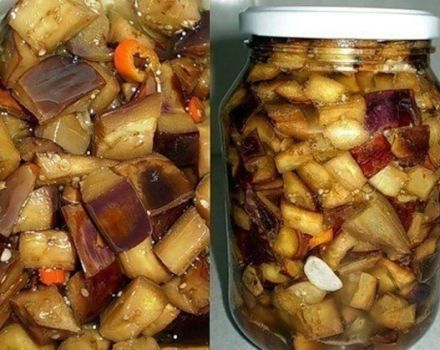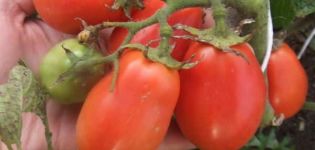How to properly care for onions in a rainy summer and when to dig them up
After planting onions-seeding and during the initial formation of heads, rain pleases gardeners. The amount of work on caring for bulb beds is reduced, because they need to be watered less often. But harvesting onions in a rainy summer requires more effort and time, it must be completed before the first days of August.
Why is a rainy summer dangerous?
Prolonged rains rarely delight gardeners when it's time to harvest the onions. If there are frequent rainfalls in July, it is difficult to grow and maintain crops. It is difficult to choose a day for cleaning if heavy rains have been falling for a whole week.
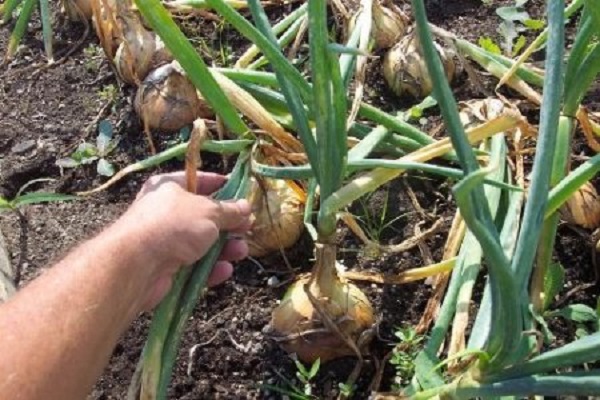
Due to wet weather, the aerial part of the onion (feather) grows strongly, and the formation of the heads is delayed. By the end of July, the neck of the bulbs should dry out, but due to excess moisture, it remains thick and juicy. Often these plants do not have a pronounced transition between stem and bulb. Such heads are not ready for cleaning, they are not suitable for long-term storage, they must be used immediately.
Damp weather creates ideal conditions for the spread of fungal diseases. Onions are affected by downy mildew and root rot. Urgent measures must be taken if grayish spots are spreading over the onion leaves. They are the main symptom of the disease. Due to excess moisture, roots, bottoms and stems rot, this causes irreparable damage to the crop.
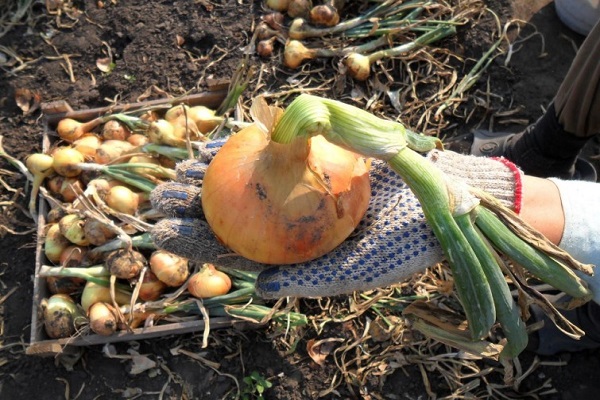
Harvesting onions in a rainy summer, recommendations for gardeners
Experienced gardeners have their own secrets on how to grow onions in rainy weather. Most of them believe that in order for it to grow well in any weather, you need:
- choose a reliable variety;
- properly prepare the ridge;
- grow and plant sevok according to the rules;
- do not forget about disease prevention.
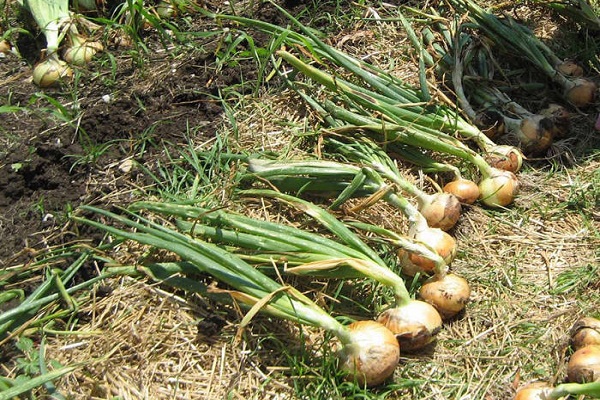
The right choice of varieties
Each region has its own weather conditions and the beginning of the rainy season can be predicted based on long-term statistics and long-term forecasts of weather forecasters. If, according to forecasts, the summer will be rainy, then you need to choose early ripening varieties of onions. It is worth paying attention to the varieties popular with gardeners:
- Candy.
- Centurion.
- Red Baron.
- Stuttgarten Riesen.
Proven onion varieties are easier to care for in rainy summers because they rarely suffer from bulbous diseases due to their short growing season. The same cannot be said about late ripening varieties. Early ripening onions are less affected by pests, less often suffer from onions. To get a good harvest, it is important not only to choose the right variety, but also to know how to plant this crop correctly and at the right time.
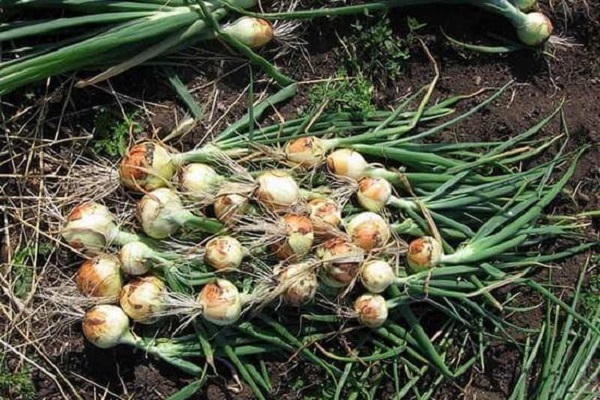
Preparing the ridges
To grow any vegetable, you need to choose the right place for it in the garden. This also applies to any type of onion.For him, the soil is prepared in the fall in an area well-lit by the sun throughout the day. An onion bed is not suitable for onions, especially if rainy weather is expected in summer.
On the eve of a rainy summer, onion ridges are made elevated and placed in a well-ventilated area of the garden. Near the onion ridge there should not be:
- tall structures;
- trees;
- shrubs.
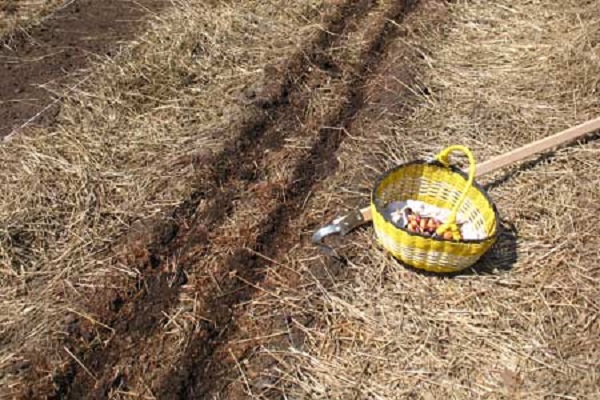
The soil in the garden bed should be light and loose. In loamy and clayey soil, it is worth adding sand or low peat to improve its structure. It should be noted the advantages of high ridges: the roots of the plant receive enough moisture, and the heads are relatively dry and well ventilated.
Compliance with landing rules
Many gardeners prefer to determine the timing of planting a turnip using the gardener's lunar calendar. When compiling it, the average temperatures for a particular region are taken into account, this greatly facilitates the planning of sowing operations. For example, for the middle zone of the Russian Federation, favorable days, suitable for planting onions in 2018, are April 8-11 and May 7-8.
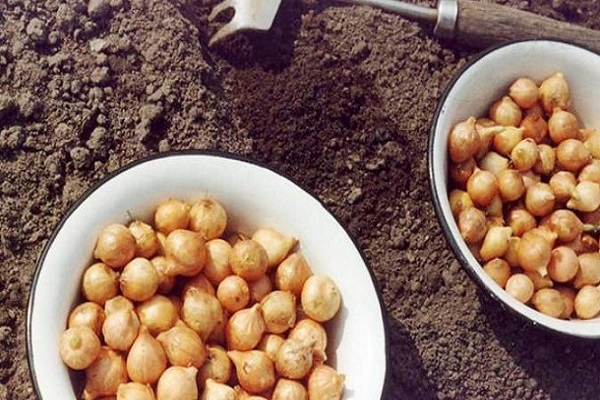
For any type of onion, the manufacturer gives planting recommendations, they must be followed. How to properly plant onion setsif a rainy summer is forecast. No need to deepen the heads during planting. The top of the set should be flush with the ground.
The head, increasing in size, will gradually bulge out of the ground, go through all stages of development. At the end of July, to accelerate the maturation of the heads, if the feather does not turn yellow for a long time, use a pitchfork or a shovel. They slightly undermine the heads. The onion continues to grow in the garden, but once the root system has been violated, the feather and neck of the bulb begin to dry.
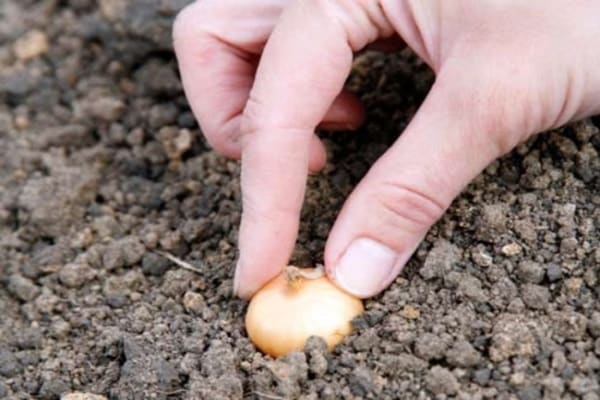
Disease prevention
Disease prevention is a guarantee of a good harvest. Correct planning of protective measures increases plant immunity and reduces the dependence of the crop on weather conditions. Although the quality of the grown turnip largely depends on the weather.
On a rainy cold summer feeding onions is carried out not with liquid fertilizers. Granules of mineral fertilizers should be scattered over the damp soil surface and buried in the ground by shallow loosening.

To protect the turnip from fungal infection, there are special chemical preparations (fungicides) on sale. Most often, gardeners in the old fashioned way use 1% Bordeaux liquid. True, after using it, the feather is not cut off for food. For fungus, many gardeners prefer to use wood ash. It is suitable dry, it is sprinkled with onion beds. Infusions are prepared from it and watered onions landing. Ash protects not only from infection, but also from many pests.
Tip: When heads begin to form, nitrogen fertilizers are not used.
In wet, rainy weather, regular check-ups can help prevent the spread of infection... Rotten heads affected by onion flies must be removed and destroyed. On days when there is no rain, you need to loosen the aisles and dust them with ash, red hot pepper or tobacco dust.
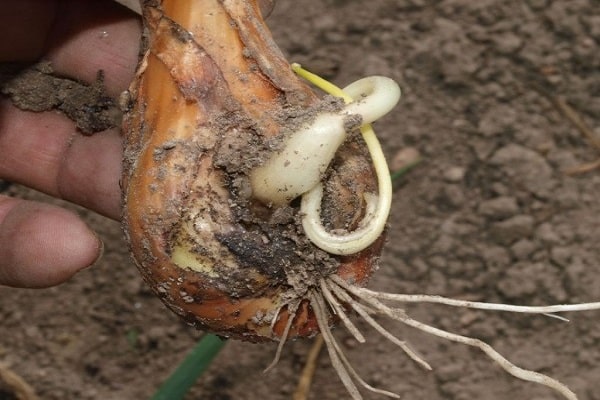
When to harvest onions?
The ripening time of onions in a rainy summer increases. If you do not carry out additional measures, then the quality of the turnip decreases, it is poorly stored and loses its presentation. Already 3 weeks before harvesting, you need to stop watering the onions, at the same time they finish all types of fertilizing with mineral and organic fertilizers.
If, according to forecasts, it is a long time to wait for the end of the rain, and it is too early to dig out the onion, then you can install arcs and cover the ridge with PVC film, but leave gaps for ventilation. Is it possible to dig onions in the rain, each gardener decides based on specific conditions:
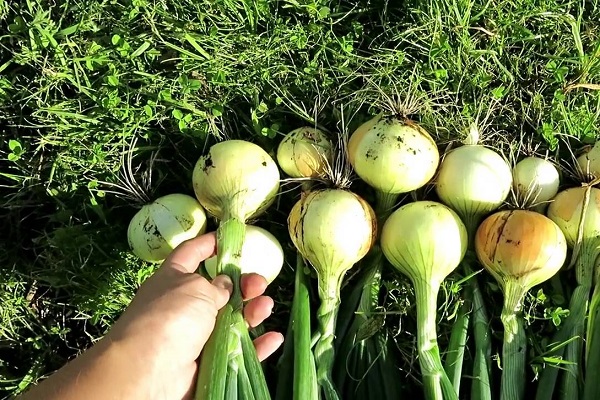
- the presence of a shed or ventilated room for drying crops;
- withered feather;
- shrunken neck;
- the presence of dry integumentary scales on the heads.
Ripening of the bulbs can be accelerated. About a week before harvesting, you need to walk along each bed and use your hands to scrape off the soil from each head. This accelerates the formation of integumentary scales and the transfer of nutrients from the feather to the bulb.
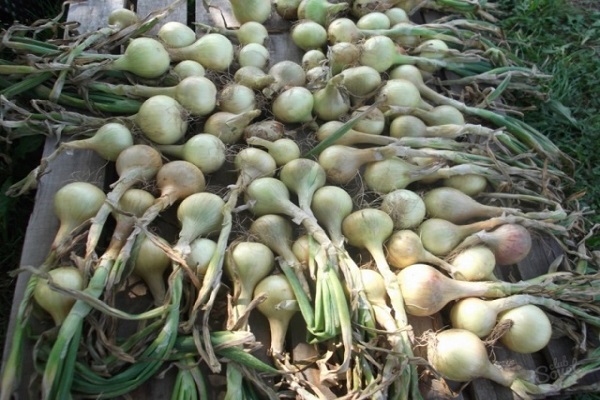
At the same time or a week later, you can use a pitchfork to undermine the root system of the turnip. At the same time, the feather will turn yellow faster, the neck will dry out, and the bulbs will be covered with scales. You do not need to trim the feather to ripen the heads. There is no benefit from this procedure, but there is harm in the form of an infection that can enter the head.
If you are lucky and the weather will please you with the absence of rain, then you need to use this moment. Dig the onion with a shovel or pitchfork and pull it out of the ground together with the tops. If there is a shed or shed, move there and lay in one layer. If there is no special drying facility, build a film shed directly above the ridge.
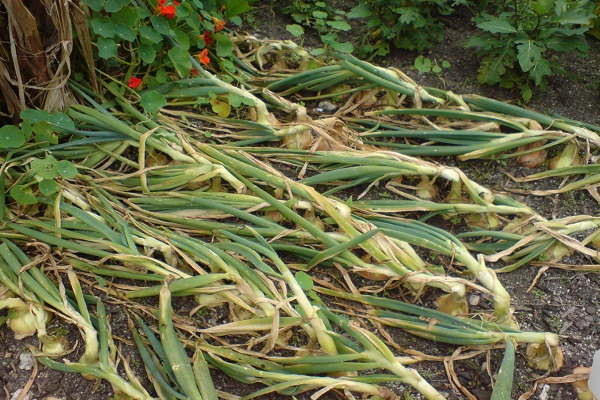
For storage, onions must be dried for at least 10 days, and in some cases even longer. The feather should dry completely during this time, the neck should close. Only then can the turnip be sent for storage. Activities for preparing onions for storage:
- clean the heads from the remnants of the earth;
- cut off the feather, leaving the neck at least 4 cm;
- heads with a thick neck to be eaten, they are not suitable for long-term storage;
- Dry the cut onions for a few more days in a warm room (25-28 ° C) or in the sun.
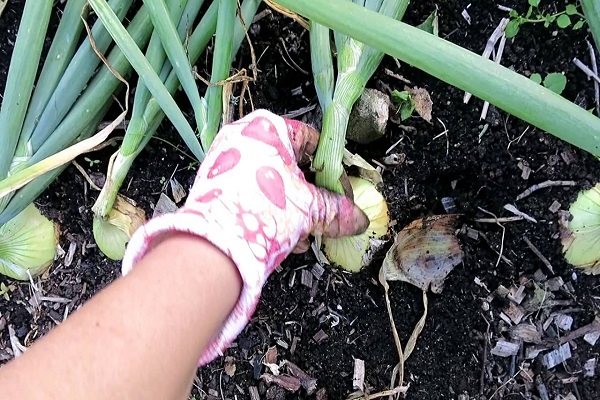
While the onions are drying, they prepare containers for storage: cardboard boxes, baskets, nets, bags. Before filling the heads for storage, you need to carefully inspect them. Bulbs showing signs of rotting or insect infestation must be discarded and destroyed.
Conclusion
Many gardeners complain about the weather, which made it difficult to grow the right amount of onions or because they are poorly stored in winter. But rain isn't always to blame. Often, onions rot not because of the damp summer, but because the variety is unsuitable for long-term storage or the seeds have not undergone pre-sowing treatment. And the harvest is bad due to poor care and lack of fertilizing.
